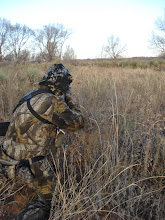Here is a pick of the grip on one. I don't know how anyone could get a grip on that. I have a couple of knives that I've been using for cleaning game and both of them have more traction when covered with blood than this does clean and dry.

I thought I could improve them without spending much more money on them. My first attempt was to use grip tape.


Grip tape works ok on the straight parts of the grip but didn't seem to stay well on the curves. Then, after the tape comes off it leaves a sticky residue which gets on your hands and picks up all kinds of dirt.
There has to be a better way and I think I found it. I borrowed a method used to modify the grips on Glocks. I probably won't be trying this on $400+ handguns but on a <$20 knife, sure. Here is my high-tech tool.
 I used the wide flat tip intended for soldering large connections that require a lot of heat. Here is a closeup of it. You could use the standard pointed tip just as well but it would probably take more time.
I used the wide flat tip intended for soldering large connections that require a lot of heat. Here is a closeup of it. You could use the standard pointed tip just as well but it would probably take more time.
Here is what the grip looked like when I first started.

Here are some pics of a couple of these after I finished.





Now for a couple of details.
First, do this in a well ventilated area. The fumes are probably hazardous and they don't smell good.
Second, be careful with the soldering iron. Obviously, it is hot and can burn you badly. Also, the material on the grip can melt and it can stick to your skin and burn you. Use the same common sense and caution that you use when soldering wires and you will be fine. I recommend eye protection.
Third, be careful of the temperature on the soldering iron. Be sure to let the temperature stabilize before you start. As the temp changes the effect on the grip changes. The iron I used was inexpensive and does not have adjustable temperature. When this iron stabilized it was a little hotter than I think would be ideal. The ideal temp depends on how fast you operate and for my speed the iron was too hot and a couple of times I got the material too hot and it made strings. If that happens then move to a different area on the grip but don't touch what you just worked on or you will mash the grooves and have to do it again.
Forth, when you finish the grips will probably be too rough and will hurt your hands. I took a small piece of sand paper and went over them when I was finished. It didn't take much. I just handled the knife, then sanded a little, and handled it again until if felt right.
These knives are much easier to handle now and I don't have to worry about one slipping when I open up an animal and stick the knife inside to take out the organs.
Overall I'm pleased with the results of my efforts.
The only problem I see is that the scabbards were intended for use with knives that have slick grips. The rough grip snags on the inside of the scabbard and pulls it out. You can see the results here.

I haven't come up with a solution for this yet. Perhaps using the soldering iron to melt the cover onto the lining. Shoe Goo might be another solution.
I will probably give a review of these knives in the future after I've had a chance to use them a bit.


2 comments:
Cool idea!
...nice...and don't worry 'bout the polypro being toxic...is safe...concentrated puffs of smoke to be avoided.
Post a Comment